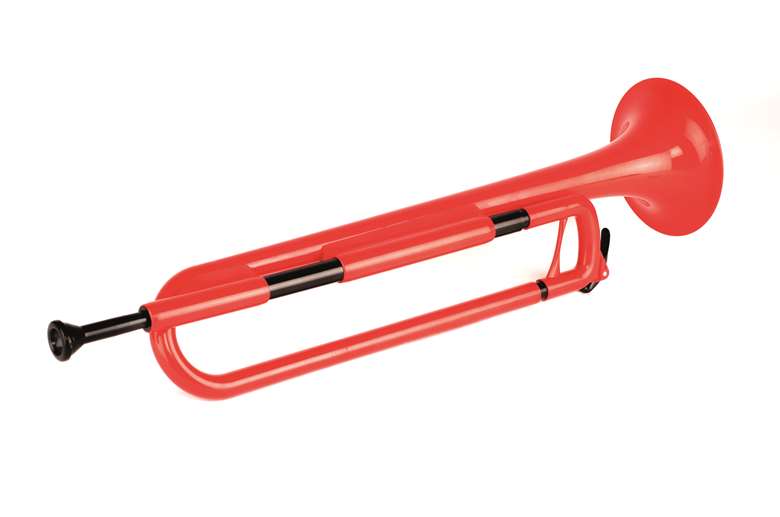Instrument Reviews: pBugle
Kevin Street
Tuesday, December 1, 2020
Kevin Street reviews the B flat pBugle from Warwick Music.

Warwick Music was the first maker of plastic ‘brass’ instruments with the introduction of the pBone in 2010, and it has now become the world leader in their manufacture. I had the pleasure of reviewing the pBone back in 2013 and it's great to see that the company has innovated further with the pTrumpet and now the pBugle.
The one I reviewed is bright red with a black mouthpiece and some black tubing. In shape it is more like a fanfare trumpet or cavalry bugle than a traditional marching band bugle. Despite its initial appearance, this is not a toy.
Its tubing is cylindrical, unlike the conical bore bugle, and this has an impact on the sound, making it brighter and more trumpet like. It comes with a tuning slide and a water key.
My younger pupils like the feel of a plastic mouthpiece compared to a metal one. They also like the lighter weight of the instrument – one of my pupils commented that it felt as light as air compared to their traditional brass trumpet.
My first impression on playing the instrument is that it feels free-blowing and in tune. The quality of the sound is much better than I anticipated, especially when considering the price. The upper register doesn't have quite the same ring as a brass instrument and sounds a little compressed. However, I would have been surprised if I hadn't found a weakness somewhere.
Of course, no bugle can play a diatonic scale and they are limited to notes within the harmonic series. Pitch is only controlled by blowing and embouchure shape.
Historically, bugles have been used mainly in military settings, sometimes played on horseback and on the battlefield to relay messages. Different bugle calls projected instructions to summon soldiers to advance, retreat, go to sleep and wake up. Traditionally, we still hear bugles played for Remembrance Sunday and every day at the Menin Gate by the Ypres fi re service buglers.
I'm not sure if the scarlet and black poppy colour would be appropriate for the Last Post at Remembrance, and the youth brigades such as Scouts and Guides may find it more respectful on the brass or silver traditional bugle.
This all leads to the obvious question: what is the market for this instrument? According to the website, Warwick Music says that it ‘will help revolutionise the teaching of brass music – especially to children wanting to join a marching band or drum corps’. It also says, ‘This is a great way to begin your trumpet journey, without the distraction and complication of valves, and at a fraction of the cost of any valved trumpet’. Also, controversially, in my opinion, ‘The great thing is that there are no wrong notes.’
I have personally always considered valves to be integral to learning the trumpet and I introduce them to pupils in their third lesson. Not providing valves does not necessarily make it any easier to play the right notes. The same embouchure challenges exist in both instruments, but with the wider intervals on the bugle, pitching comes more difficult.
A pupil in their first term on a valved trumpet may be able to play a good range of tunes based on the staple first five notes of a scale, which will sustain interest. I wonder if beginner buglers, who have fewer notes within a similar range, could become bored and would go in search of higher notes too early, which could lead to bad habits through incorrect technique.
Buglers often play their tunes while marching, so the purpose of their rehearsals are for memorisation of the tunes and routines. The military bugle calls often had unsung words associated with them as an aide memoire such as, ‘get out of bed’, ‘come to the cookhouse door’ or ‘lights out’, and there could be a creative project for beginner players to invent their own calls with hidden messages in the music. The pBugle would survive being dropped by young hands, but I wonder if they might sound like a swarm of vuvuzelas in the first rehearsal!
So, the pBugle is aimed at the young musician who will no doubt love the look and feel of this low cost instrument and it might pique their curiosity about brass instruments in general, which is no bad thing.
It would make a great Christmas present, but hopefully it wouldn't be long before a pupil would be asking for an upgrade to a shiny brass, diatonic instrument.

